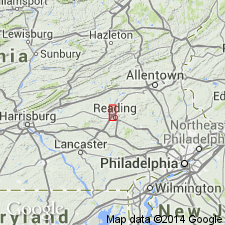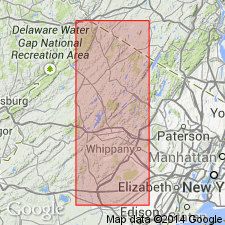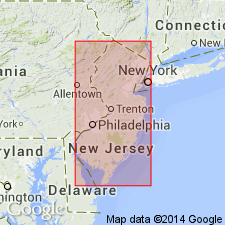
- Usage in publication:
-
- Ontelaunee formation
- Modifications:
-
- Named
- Dominant lithology:
-
- Dolomite
- Limestone
- Chert
- AAPG geologic province:
-
- Appalachian basin
Summary:
Name Ontelaunee formation proposed for the dolomite and interbedded limestone and chert lying above Epler formation (new) and underlying either Annville limestone, Jacksonburg argillaceous limestone, or Martinsburg shale. Formation is 675 ft thick near type locality and is divided into three unnamed members: upper interbedded limestone and dolomite member, middle dolomite member, and lower interbedded chert and dolomite member. Thins to 150 to 250 ft near Reading. Contact with Epler is placed at top of first limestone beneath lowest chert bed of Ontelaunee. Contact zone is gradational. Line demarcating contact in Berks Co. is placed 100 ft below lowest chert bed of Ontelaunee. Age is Early Ordovician.
Source: GNU records (USGS DDS-6; Reston GNULEX).

- Usage in publication:
-
- Ontelaunee Formation*
- Modifications:
-
- Age modified
- Areal extent
- AAPG geologic province:
-
- Appalachian basin
Summary:
Beekmantown Group assigned to Kittatinny Supergroup, raised in rank from Kittatinny Limestone. Age of Ontelaunee extended to Middle Ordovician. Unit recognized in NJ. Underlies Jacksonburg Limestone and unconformably overlies Hardyston Quartzite in this area.
Source: GNU records (USGS DDS-6; Reston GNULEX).

- Usage in publication:
-
- Ontelaunee Formation
- Modifications:
-
- Overview
- AAPG geologic province:
-
- Appalachian basin
Summary:
Unit was recognized in NJ by Dalton and Markewicz (1972: Bulletin of the National Speleological Society, v. 34, p. 115-128) though Hobson (1963) and Drake (1969) did not recognize the Ontelaunee other than in PA. The thickness of the formation depends on the amount of erosion at the Knox-Beekmantown unconformity. In the Phillipsburg area, the Ontelaunee probably exceeds 800 ft. Nomenclature in this report follows Markewicz and Dalton (1977) who divided the formation in NJ into the Beaver Run Member and the Harmonyvale Member. The Beaver Run is 150 to 200 ft thick and contains three distinct units: 1) lower massive, medium-to coarsely crystalline, black, sparkly, fetid dolomite; 2) massive dolomite similar to the lower part but with a large amount of bedded, anastomosing, rugose, and knotted chert; and 3) upper massive, fine- to medium-grained, black sparkly, fetid dolomite, generally with little chert. The Harmonyvale is the youngest of the Early Ordovician rocks in NJ. Thickness exceeds 220 ft although in many places unit has been completely eroded away and the Jacksonburg rest directly on the Beaver Run. The Harmonyvale consists of a dense, fine-grained to cryptocrystalline, conchoidal fracturing, stylolitic dolomite. Some beds weather to a strongly dissected crosshatch surface referred to as "elephant-hide rock" by Hobson (1963). The base of the Ontelaunee as defined by Markewicz and Dalton (1977) does not coincide exactly with that of Hobson (1963). Hobson may have included a part of the Lafayette Member in the Ontelaunee. Base here considered to be at the change from the fine-grained laminated dolomite of the Lafayette to the coarser-grained dolomite of the Beaver Run. Age shown as entirely within the Early Ordovician. [This age assignment disagrees with Drake and Lyttle (1980) who extended the age into the Middle Ordovician.]
Source: GNU records (USGS DDS-6; Reston GNULEX).
For more information, please contact Nancy Stamm, Geologic Names Committee Secretary.
Asterisk (*) indicates published by U.S. Geological Survey authors.
"No current usage" (†) implies that a name has been abandoned or has fallen into disuse. Former usage and, if known, replacement name given in parentheses ( ).
Slash (/) indicates name conflicts with nomenclatural guidelines (CSN, 1933; ACSN, 1961, 1970; NACSN, 1983, 2005, 2021). May be explained within brackets ([ ]).

